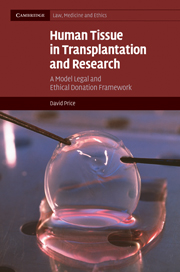Book contents
- Frontmatter
- Dedication
- Contents
- Preface
- Table of cases cited
- Table of selected statutory sources
- Introduction
- 1 Human biological materials
- 2 Interests in the living body and corpse
- 3 Eliciting wishes
- 4 Consent to donation
- 5 Presumed consent
- 6 Informed consent
- 7 Living donation
- 8 Property in human material
- Conclusion
- Index
- References
6 - Informed consent
Published online by Cambridge University Press: 05 July 2014
- Frontmatter
- Dedication
- Contents
- Preface
- Table of cases cited
- Table of selected statutory sources
- Introduction
- 1 Human biological materials
- 2 Interests in the living body and corpse
- 3 Eliciting wishes
- 4 Consent to donation
- 5 Presumed consent
- 6 Informed consent
- 7 Living donation
- 8 Property in human material
- Conclusion
- Index
- References
Summary
The taking, storage and use of human material for research has emerged as a major legal and bioethical sphere of contention. Gostin has remarked that ‘the legal and ethical issues about the use of stored tissue are probably the most profound, complex, and troubling of any ethical issue we have in science today’. Historically, consent was not routinely sought for the storage and use of human tissue for research. This was principally a function of the fact that most tissue used for research was not removed originally for such (secondary) purposes, but instead as part of a diagnostic or therapeutic procedure. In 1994 the Health Council of the Netherlands Report, Proper Use of Human Tissue, stated ‘It is not usual to seek consent to the storage of tissue, other than in the case of material primarily intended for use in research . . . The general rule that emerges is that patients and donors are not aware that material taken from them is stored.’ Similarly with regard to the US, Clayton states ‘In the past, it appears that investigators sometimes used these resources with relatively little oversight, and without the consent of the individuals from whom these materials and information were obtained’. Indeed, this appears to have been the case with respect to the use of surplus clinical material for any purpose, including tissue transplantation, not just research. Anderson and Bottenfield note that femoral heads removed during hip replacement surgery have been routinely banked (in the US and elsewhere) and that patients were often not informed that their tissue might be used for another patient, i.e. as part of a bone transplant. Such remarks are equally pertinent with regard to tissue taken from the dead at post-mortem examination. As Rosie Winterton, speaking for the Government, stated during the passage of the Human Tissue Bill, ‘It had become routine for tissue taken post mortem to be kept for archives, research and education, but without proper discussion with those close to the deceased’.
- Type
- Chapter
- Information
- Human Tissue in Transplantation and ResearchA Model Legal and Ethical Donation Framework, pp. 168 - 195Publisher: Cambridge University PressPrint publication year: 2009



